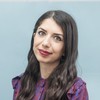"I feel like there's this sort of 'trans moment' happening—which is a great thing, obviously. But that still very often fits the binary of male to female, or female to male. And a lot of my friends—the people I love and interact with every day—identify as non-binary, as do I. But there's not so much representation around that. I wanted to give non-binary people a public face."Canadian photographer Laurence Philomène is explaining the impetus behind her new non-binary portrait series, published exclusively on Broadly. Despite being only 23, Philomène—who uses she/her and they/them pronouns—has achieved the kind of distinctive aesthetic many photographers spend decades creating.
Advertisement
Philomène's work is characterized by her use of color. Images are typically monochromatic, or dominated by single, vibrant hues. Philomène herself often appears, in profile or face hidden by a characteristic brightly colored wig, sometimes in effervescent orange, other times bubblegum blue."I just wanted to step out of myself with this series, and make work that's not only about me for one hot minute," Philomène jokes. "I've got a pretty distinctive style, and I've been shooting everyday for eight years. Portraiture for me is a way to spend time with people, befriend them, interact with them on that different level. Or I'm friends with them, and it gives me a reason to hang out with the people I love."
Ciara. All photos by Laurence Philomène
For the portrait series, Philomène asked her friends to pose as their idealized selves: either playfully approximating a character, or portraying themselves as they'd like to be perceived. They might take a favorite item of clothing as a point of departure, or dress like their best version of themselves. "My friend Billy is obsessed with Dolly Parton so we went for that look. Or Hobbes wants to be a skater girl, so we went to a skate park and did that."
As we speak, Philomène requests that we don't describe her photographs using descriptors like "redefining," as in, "they're redefining what it means to be non-binary." It's a justifiable response to the ways in LGBTQ or non-binary people are often pulled into a media narrative they have no desire to be part of. Philomène's not trying to recalibrate what it means to be non-binary: She's just representing some of her favorite humans, as they'd like to be seen. That said, post-Trump, Philomène views her portrait series as politically important. "I feel like in this day and age, being a visible part of the LGBTQ community is a political act in itself," she explains.Read more: Photos of Honeymoon Horrors in a Pennsylvania Love Hotel
Advertisement
You can check out the first part of Philomène's series below, exclusively on Broadly.
Benjamin Da Silva
Hobbes Ginsberg wanted to be photographed as a skater
Lucky wanted to be shot like an 80s cartoon character
Billy Starfield wanted to be Dolly Parton for a day
Lux
William
Hobbes with daisies
Ciara
Lux
